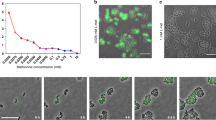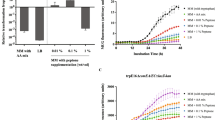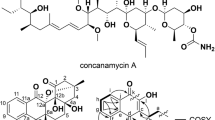Abstract
We have devised a direct selection for auxotrophic mutant isolation, and report here its use to obtain a xanthine-requiring mutant of B. subtilis that shows significantly improved inosine production. Insertion of a chloramphenicol acetyl transferase gene into a cloned B. subtilis IMP dehydrogenase gene on pBR322 was followed by transformation of inosine-guanosine producing B. subtilis with a fragment of the mutagenized plasmid. All chloramphenicol resistant transformants were xanthine dependent and accumulated almost twice as much inosine as the parental strain.
This is a preview of subscription content, access via your institution
Access options
Subscribe to this journal
Receive 12 print issues and online access
$209.00 per year
only $17.42 per issue
Buy this article
- Purchase on Springer Link
- Instant access to full article PDF
Prices may be subject to local taxes which are calculated during checkout
Similar content being viewed by others
References
Nakao, Y. 1979. Microbial production of nucleosides and nucleotides, p 311–354. In: Microbial Technology Vol. 1, Peppler, H.J., and Perlman, D. (Eds.) Academic Press, New York.
Miyagawa, K., Kimura, H., Nakahama, K., Kikuchi, M., Doi, M., Akiyama, S. and Nakao, Y. 1986. Cloning of the Bacillus subtilis IMP dehydrogenase gene and its application to increased production of guanosine. Bio/Technology 4:225–228.
Matsui, H., Sato, K., Enei, H. and Takinami, K. 1982. 5′-Nucleotidase activity in improved inosine-producing mutants of Bacillus subtilis. Agric. Biol. Chem. 46:2347–2352.
Kotani, Y., Yamaguchi, K., Kato, F. and Furuya, A. 1978. Inosine accumulation by mutants of Brevibacterium ammoniagenes; Strain improvement and culture conditions. Agric. Biol. Chem. 42:399–405.
Nakahama, K., Miyazaki, T. and Kikuchi, M. 1985. A promoter for Bacillus subtilis expression vectors. Gene. 36:179–182.
Williams, D.M., Duvall, E.J. and Lovett, P.S. 1981. Cloning restriction fragments that promote expression of a gene in Bacillus subtilis. J. Bacteriol. 146:1162–1165.
Maniatis, T., Fritsch, E.F. and Sambrook, J. 1982. Molecular Cloning. A Laboratory Manual. Cold Spring Harbor Laboratory, Cold Spring Harbor, New York.
Saito, H. and Miura, K. 1963. Preparation of transforming deoxyribonucleic acid by phenol treatment. Biochem. Biophy. Acta. 72:619–629.
Cohen, S.N., Chang, A.C.Y. and Hsu, L. 1972. Nonchromosomal antibiotic resistance in bacteria: Genetic transformation of Escherichia coli by R factor DNA. Pro. Natl. Acad. Sci. U.S.A. 69:2110–2114.
Anagnostopoulos, C. and Spizizen, J. 1961. Requirements for transformation in Bacillus subtillis. J. Bacteriol. 81:741–746.
Author information
Authors and Affiliations
Rights and permissions
About this article
Cite this article
Miyagawa, Ki., Kanzaki, N., Kimura, H. et al. Increased Inosine Production by a Bacillus subtilis Xanthine-Requiring Mutant Derived by Insertional Inactivation of the IMP Dehydrogenase Gene. Nat Biotechnol 7, 821–824 (1989). https://doi.org/10.1038/nbt0889-821
Received:
Accepted:
Issue Date:
DOI: https://doi.org/10.1038/nbt0889-821



